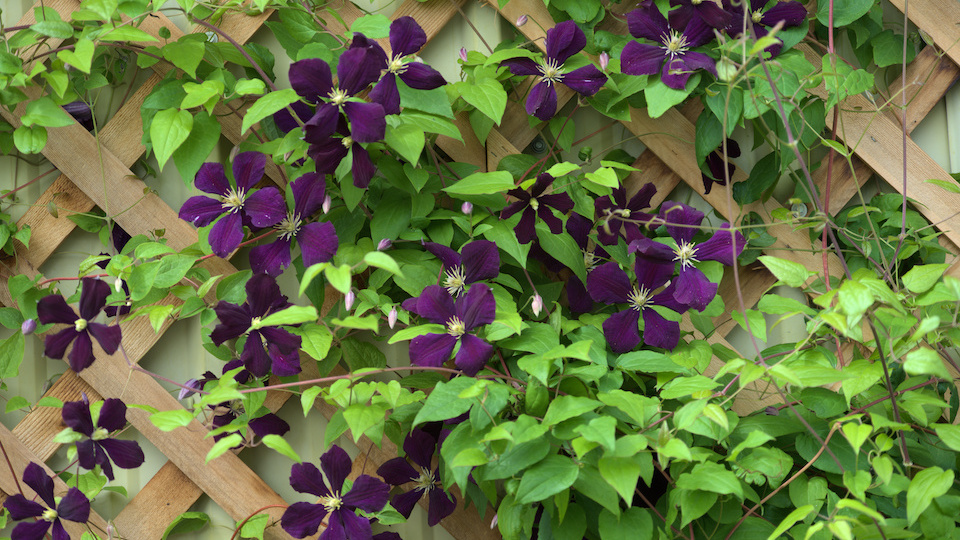There’s nothing like a flowering vine to really tie your yard together and add a unique visual element. Once you have put structures in place, such as fences or trellises, turn to this guide for the best, most attractive vines you can grow today.
Sweet Pea
Unlike other vines on this list that have a large growing pattern, the perennial sweet pea won’t grow taller than 6 feet, which makes it an excellent vine for that small vertical space that you’ve been struggling to fill. Its pink or white blooms will add delicate color to any fence or trellis. Keep in mind; sweet pea is considered invasive in certain areas, so be sure to check any local invasive plant guidelines before adding it to your garden.
Carolina Jasmine
Perhaps one of the most fragrant vines, Carolina jasmine, will add something really special to your garden. Not just because it smells good, but because this languid vine will stun with its explosion of yellow blooms.
Climbing Hydrangea
Like its non-climbing variety, climbing hydrangea prefers shade and is the perfect choice for trailing around the posts of a shaded gazebo or sheltered porch. It produces beautiful white flowers and will bloom abundantly when the soil is kept moist and well fertilized. Keep in mind; this plant will take a few years to grow to maturity, so be patient and enjoy the stunning sight of your climbing hydrangea once it is established.
Clematis
Clematis is a broad term for a wide variety of plants within a specific family. In fact, over 300 species fall under the genus Clematis. These plants differ in a lot of ways, with some forming a bush and others trailing up a wall, trellis, or fence. Overall, however, they all have woody stems and produce tons of lovely flowers in the spring and summer. Be sure that you purchase a climbing variety and attach it loosely to your trellis with a piece of twine. Once the plant has started growing, it shouldn’t need much training and will twine through a trellis or weave together with other vines.
Purple Passionflower
Pretty much no other flower can compare to the unique passionflower. Its delicate purple color and intriguing layers burst forth from hundreds of flowers on a single vine. Plus, many varieties produce an interesting fruit that can be edible under the proper conditions. It produces small tendrils that reach out and wrap around any available surfaces, making it incredibly easy to train wherever you desire. Certain caterpillars may be attracted to this plant and munch on the leaves, but don’t deter them. The foliage will grow back, and you’ll be able to enjoy beautiful butterflies in a few weeks.
Trumpet vine
If you’re looking for a vine that will quickly sprout up and cover your vertical surface, then the trumpet vine is for you. This plant can be planted in virtually any growing region and will thrive in even the harshest conditions, producing beautiful orange, red, or yellow blooms that will catch the eye and attract all sorts of beneficial pollinators. It can become invasive in certain environments, so it is critical to do your research before planting. Be sure to provide a sturdy structure to support the woody nature of this plant and its sprawling tendencies. Since it can grow up to 40 feet tall, it may require occasional pruning to keep it under control.
Chocolate vine
Perhaps a bit more exotic-looking than others on this list, the aptly named “chocolate vine” produces brown to purple flowers that hang down from the vine in small, round clusters. As with other fast-growing vines, this chocolate vine can quickly take over any fence or wall that it is trained to, which is a good thing if you want to coverage fast, but could prove to be a problem as it may become invasive.
Wisteria
Ah, wisteria. If you live in the southeast, you might consider wisteria a weed, as it is so persistent and will twine around trees, overtaking them and creating “wisteria trees” in many cases. However, this beautiful vine is often overlooked when it comes to good garden options. In reality, it is an incredibly stunning addition, with purple, blue, pink, or white blooms that hang down and create a dream-like scene, reminiscent of the finest romantic-era painting. It may be best to avoid planting wisteria if you live in a warmer climate, but if you live in an area that receives a freeze in the winter, wisteria could be a great option to your vertical garden.
Though many of the vines on this list are considered “invasive,” don’t let that scare you. It often just means that your vine will require a little more care and attention, including pruning to help it stay in its proper spot. Once you get the hang of it, pruning is incredibly easy so don’t worry about embracing these slightly unruly vines. They’re well worth it in the end.
-Taylor Ramsey




